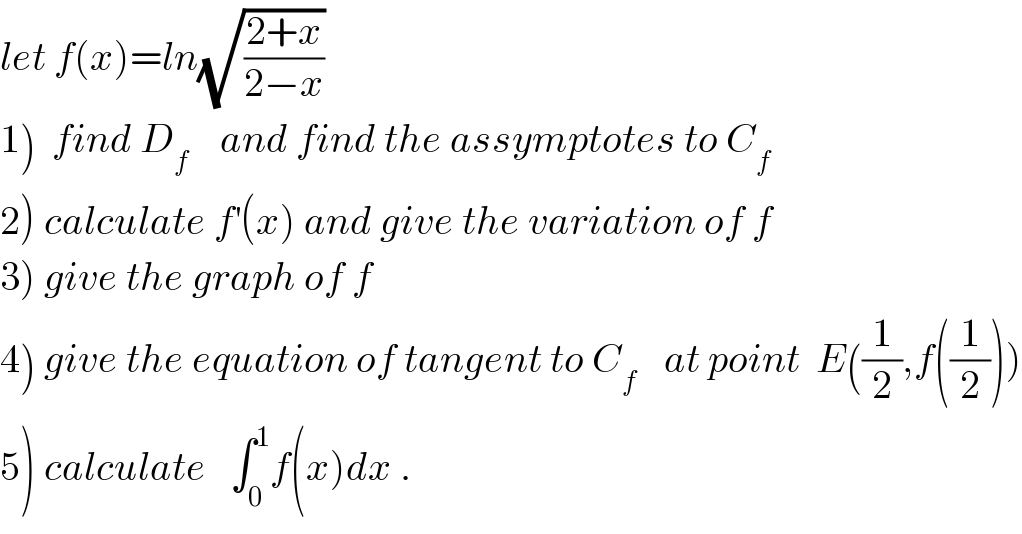
Question and Answers Forum
Previous in Relation and Functions Next in Relation and Functions
Question Number 40097 by maxmathsup by imad last updated on 15/Jul/18

Commented by math khazana by abdo last updated on 03/Aug/18
![1) D_f =]−2,2[ lim_(x→−2^+ ) f(x)=−∞ lim_(x→2^− ) f(x)=+∞ so x=−2 and x=2 are assymptotes to C_f 2) we have f(x)=(1/2){ln(2+x)−ln(2−x)}⇒ f^′ (x)= (1/(2(2+x))) +(1/(2(2−x))) =(1/2){(1/(2+x)) +(1/(2−x))} =(1/2) (4/(4−x^2 )) =(2/(4−x^2 )) > 0 because −2<x<2 so f is increasing on]−2,2[ 4) equ.of tangent is y=f^′ ((1/2))(x−(1/2))+f((1/2)) f^′ ((1/2))= (2/(4−(1/4))) =((2×4)/(15)) =(8/(15)) f((1/2)) =(1/2)ln(((2+(1/2))/(2−(1/2)))) =(1/2)ln((5/3)) ⇒ y =(8/(15))(x−(1/2)) +(1/2)ln((5/3)) y=(8/(15))x −(4/(15)) +(1/2)ln((5/3)).](Q41211.png)
Commented by math khazana by abdo last updated on 03/Aug/18
![5) let I = ∫_0 ^1 ln((√((2+x)/(2−x))))dx I = (1/2)∫_0 ^1 ln(2+x)dx −(1/2) ∫_0 ^1 ln(2−x)dx but ∫_0 ^1 ln(2+x)dx =_(2+x=t) ∫_2 ^3 ln(t)dt=[tln(t)−t]_2 ^3 =3ln(3)−3−2ln(2)+2 =3ln(3)−2ln(2)−1 ∫_0 ^1 ln(2−x)dx =_(2−x=t) −∫_2 ^1 ln(t)dt =∫_1 ^2 ln(t)dt =[tln(t)−t]_1 ^2 =2ln(2)−2 +1 =2ln(2)−1 ⇒ ∫_0 ^1 f(x)dx=(3/2)ln(3)−ln(2)−(1/2) −ln(2) +(1/2) =(3/2)ln(3)−2ln(2).](Q41213.png)
